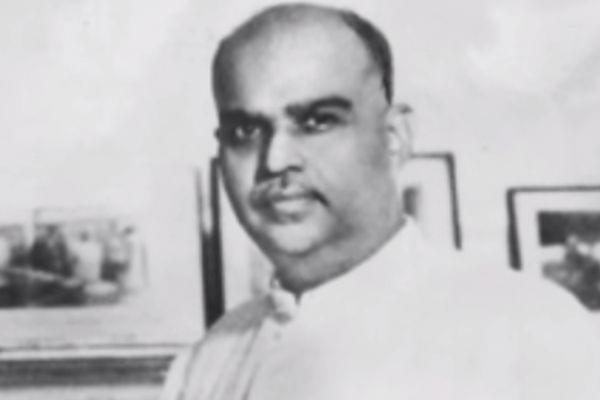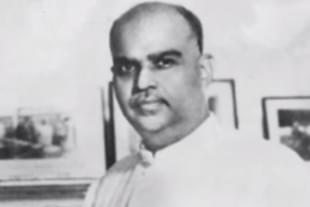Politics
Why Syama Prasad Mookerjee Is Relevant Today
Anirban Ganguly
Jun 23, 2019, 04:36 PM | Updated 04:36 PM IST
Save & read from anywhere!
Bookmark stories for easy access on any device or the Swarajya app.


One of the starkest manifestations of the Nehruvian consensus has been the marginalisation, in our national discourse, of non-Nehruvian or non-Congress leaders, both of thought and of politics. These were the leaders who challenged Nehru’s political methods and direction; the ones who dared to evolve an alternative framework for national regeneration by drawing inspiration from the deeper civilisational fountains of Indian experience.
There was a peculiar character trait of the Nehruvian system or state. Those who spoke of a different route of national progress, or those who advocated the need to derive direction and inspiration from our essential civilisational and cultural self, were hardest hit or most severely attacked by the system; their legacies or contributions in independent India largely ignored or shrouded in a mist of obfuscation.
Dr. Syama Prasad Mookerjee, whose 114th birth anniversary falls on this 6th July, was one such stalwart whose legacy would have long been erased had it not been for the determined struggle waged by the political party he founded in independent India.
Rarely does one come across such versatility and such a multifarious action packed life as Syama Prasad Mookerjee’s. And that too a life, that all but spanned fifty-two years, only the last fourteen of which were spent in active politics. Whether it was imparting a new direction to Indian education within the confines of the still-prevailing colonial system; or reaching out to the wider world and inviting its educational institutions to engage with India; or encouraging Indian scholars to undertake excavations and promote the study of Indian history from a liberated Indian perspective; or the setting up of a museum within the University or encouraging the growth of Bharatiya languages, as the youngest Vice-Chancellor of the University of Calcutta, Syama Prasad, in his tenure, succeeded in giving an altogether refreshing and bold educational path.

While Syama Prasad’s father, Asutosh Mookerjee— himself a legendary educationist and juridical icon— going against convention, bestowed on Rabindranath Tagore a doctorate, Syama Prasad invited Tagore in 1937 to deliver the University convocation address in Bengali – the first such invitation in the annals of the University. It was a move that repositioned to some centrality the importance of Indian languages in the cultural and political regeneration of India. A deeply moved Tagore, in his address, referred to how Syama Prasad’s father had “carved a channel…through which the Bengali language could flow into” the precincts of the university and how now his ‘worthy son and successor” had widened that channel for which he deserved the “blessings of his motherland.” In fact, it was such unconventionality, and non-conformism that always characterised Syama Prasad’s public action, be it in the field of politics, education or administration.
The sanctions of a colonial system, the stranglehold of the colonial education machinery could never deter him from speaking his mind out on the degradation of India under foreign yoke. Addressing the students of the University of Patna, for example, on their Convocation day sometime in 1937, Syama Prasad, unequivocally described the detrimental effects of foreign rule on our educational direction and priorities. “We must boldly take stock”, he reminded his young audience, “of the things that we have lost and yearn for. We find a general decay of the creative Indian arts which once triumphantly flourished in this land, and produced the frescoes of Ajanta and the Taj of Agra, Indian music, Indian art and architecture, and Indian literature…We witness the decline and disappearance of the indigenous industries of India which mainly thrived in her own towns and villages. Such cottage industries, if they are to be revived, developed and saved from foreign competition require the unstinted support of the state. We find also deplorable neglect of the health and welfare of the villages of India which are today but shadows of their former affluence and happiness. Indeed much of India’s poverty and distress is traced to systematic pursuit of an economic and industrial policy which has not been prompted and administered in the sole interest of India and her inhabitants.”
His concern for evolving a wide base of research on civilisational subjects that would aid in articulating the Indian narrative saw forceful reiteration years later in independent India.
Addressing the students and faculty of Delhi University in 1952, perhaps his last educational address, Syama Prasad broached an agenda which would remain largely unfulfilled or adversely addressed in the decades that followed. In this articulation of his comes his essential self and world-view, that of an educationist eager to blend India’s civilisational acquisitions and repositories with the exigencies of the present and at the same time eager to disseminate these to a world eagerly looking towards India for light and knowledge.
Syama Prasad consistently argued for the need to encourage research “on subjects which have a special relation to the Indian problems of today or the basic conception of Indian culture and civilisation. Indian History, Indian Thought and Philosophy, Indian Art, Architecture, Music and Indian Sociology afford field for laborious work by hundreds of scholars. The fruits of their study and investigation are bound to produce new light which will help us in remodeling the structure of our society and the pattern of our lives in a worthy manner. Information on these subjects is widely sought for today by people coming from distant lands…To unearth the hidden wisdom of our country is not to seek benefit for ourselves alone, enabling us to appreciate our heritage, but also to share it with the rest of the world.”
His presence, his commitment to the causes he championed inspired confidence not only among Syama Prasad’s adherents and among those who once politically opposed him but also among some of the leading minds of his era. It is little known or discussed that it was Sardar Patel who pushed for Syama Prasad’s entry in the first cabinet of independent India. When as a disciplined political soldier and worker, Syama Prasad is said to have asked Savarkar on the course he should adopt over Patel’s proposal, Savarkar, displaying his essential statesmanship and vision, advised Syama Prasad to accept the offer as it would give an opportunity to directly work for India’s regeneration. Such aspects or actions of these leaders have been conveniently consigned to the dungeons of oblivion lest they upset the carefully crafted and politically potent false image that has served a certain political line.
It is little known, for example, that when the son of the iconic revolutionary-nationalist Bagha Jatin (Jatindranath Mukherjee) asked Sri Aurobindo as to what their course of political action must be in Muslim League dominated Bengal, the Sage of Pondicherry is said to have instructed them to join Syama Prasad and to strengthen his work for the Hindus of Bengal. Even in his acceptance to join the Fazlul Haq government in Bengal as Finance Minister Syama Prasad displayed an astute political sense by ensuring, at least for a while, the sidelining of the Muslim League and exposing the colonial Bengal administration, especially its Governor’s designs to up the ante on the communal front and keep the state on a perennial state of uncertainty and conflict.
In a letter to the then Bengal Governor, Syama Prasad wrote, that:
“for the first time in the history of British India, whatever democratic constitution has been handed over to us, in spite of its manifold defects, was sought to be worked in Bengal by Hindu and Muslims representatives who wielded considerable influence over their own community. The success of this experiment naturally would give a lie direct to the plea of communal disharmony standing in the way of India’s political advancement.”
While the Governor and his secretariat, “particularly the British and pro-Muslim League personnel,” did “everything possible to discredit the ministry, by putting hindrances in the way of its smooth sailing and encouraging the Muslim League opposition to kick up communal trouble”, Syama Prasad performed as one of the best Finance Ministers. It was also a period when after a long interval, the Hindus of Bengal began feeling completely safe and assured. The rabid Islamist elements, the Leaguers and colonial cronies were for the first time sidelined in Bengal politics.
In his personal life and political conviction Syama Prasad Mookerjee’s pragmatism, fearless commitment to the democratic spirit and polity of India and especially to her integrity is what defined and set him apart and above many of his peers. While Nehru spoke of crushing dissent and opposition, Syama Prasad spoke of annihilating and crushing that mentality itself. It was largely due to his dexterous statesmanship and vision that an opposition block could evolve and survive the Congress’s steam-rolling tendencies. In his short years in Parliament, he not only strengthened the fledgling republic’s democratic ethos but also displayed a remarkable appreciation of the federal spirit. Perhaps he was cautioning against a growing Nehruvian tendency when he once observed, that the function of a leader is “to try and bring out the best among his people and not to hesitate to correct their weaknesses – for every nation and every community has its weaknesses: [and] if instead leaders of the people try to follow the easier course – to appeal to weaknesses or to encourage tendencies that they know to be adverse to sound development – then the result will be not be progress but decline and disaster.”
In the end, as he once observed with great prescience, “Nations live or die according to the character of the people. Wealth, arms, munitions, disciplined armies and navies and air forces are of splendid service but the character of the people, the character in to which the youth is growing, determines the life or death of the nation.”
It augurs well that in the changed political atmosphere of the last one year, Syama Prasad Mookerjee’s vision of civilisational India, and the evolution of her present and future have greater scope for fulfillment and fruition. That would eventually mean the complete dissolution of the Nehruvian narrative and its debilitating expressions and effects.
Anirban Ganguly is a scholar of Indian civilisation-history-culture. He is also a director of Dr. Syama Prasad Mookerjee Research Foundation





